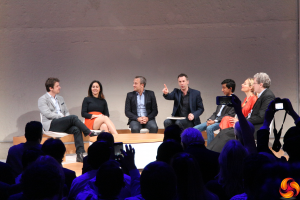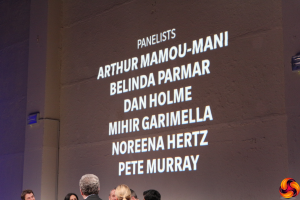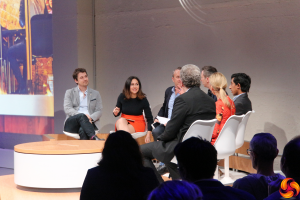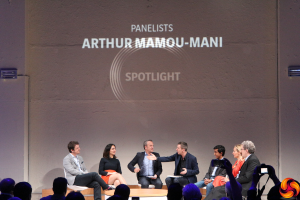The next part of proceedings involved a panel chaired by Spencer Kelly once more, with a diverse range of panellists. They began by explaining what annoyed them about the modern workplace in three words, citing things like lack of empathy, noise overpowering signal, too much process, (the lack of) time to think or politics, waste, and complexity.
The panel argued that young people just entering the workplace, also known as Generation Z, could now look forward to having 20 different jobs, when the average used to be just 4. This means that they will be less loyal, and companies will need to work harder to keep their employees. Panellist Belinda Parmar argued that the future belonged to the emotionally literate geek.
However, when Parmar claimed that today's young people are more individualistic and lack empathy, panellist Noreena Hertz disagreed, saying that things like gender equality and support for transgender rights were hardwired into the new youth workforce, which she called Generation K, after the Hunger Games' Katniss Everdeen. But everyone agreed that this generation, born between 1995 and 2002, could not live without their smartphones.
As Coupland had argued earlier, ubiquitous Internet was seen as a game changer, for example transforming our communication habits from short phonecalls to hours on Skype. In this context, it was key to use this technology to build bridges and create value from the possible connections.
The panel then turned to perhaps the most significant emerging disruption in the workplace – artificial intelligence. Spencer Kelly quoted research where 61 per cent of respondents said they would be unhappy to receive instructions from an AI boss. But that meant that 39 per cent WOULD be happy to be managed by an AI. However, architect Arthur Mamou-Mani argued that AI wasn't necessarily a replacement but an augmentation. An architect might not design a panel directly, but would define the criteria that the computer would use to generate its design – the DNA that went into creating it.
Quoting from a recent report by McKinsey, the panel argued that only 5 per cent of current jobs could be completely automated, but 60 per cent could be 35 per cent automated. Another statistic claimed that 80 per cent of jobs paying under $20 would be automated. Like Coupland, they asked if you could really replace the jobs usurped by AI via retraining. Would those displaced be able to acquire a new skillset? Could they be creative, or were they only capable of the jobs that were becoming obsolete? This was seen as far from just an issue for blue collar workers, with a Japanese firm, for example, making 30 actuaries redundant because computers could do their jobs better.
Everyone agreed that in the future workers could end up with a lot more free time, but what would people do with it all, and would it be shared equally? Whilst over the last decade we have seen dramatic developments in technology, this hasn't led to a decrease in inequality. In fact, the opposite has been the case. Although trends like maker culture, involving 3D printers and simple coding, were providing a fast track for creativity, how many people living on a council estate are tinkering with 3D printers? This seems a particularly important point, as we blame immigrants for stealing our jobs but maybe robots are more the culprits, and even more so their owners.
Another key area for the future workplace is the Internet of Things (IoT). Although consumers are experiencing this primarily through fitness bands and smart energy meters, the effect of building a workplace that is aware could be even greater. The panel argued that 80 per cent of companies would be experimenting with IoT by 2019, and those already doing so were seeing greater returns than planned. Once the IoT infrastructure has been installed, more applications than originally imagined were being discovered.
That was the context of workplace futures, but how was Konica Minolta going to address these trends? This took us to the next phase of the event – the product launch we had been lured into attending.
 KitGuru KitGuru.net – Tech News | Hardware News | Hardware Reviews | IOS | Mobile | Gaming | Graphics Cards
KitGuru KitGuru.net – Tech News | Hardware News | Hardware Reviews | IOS | Mobile | Gaming | Graphics Cards






